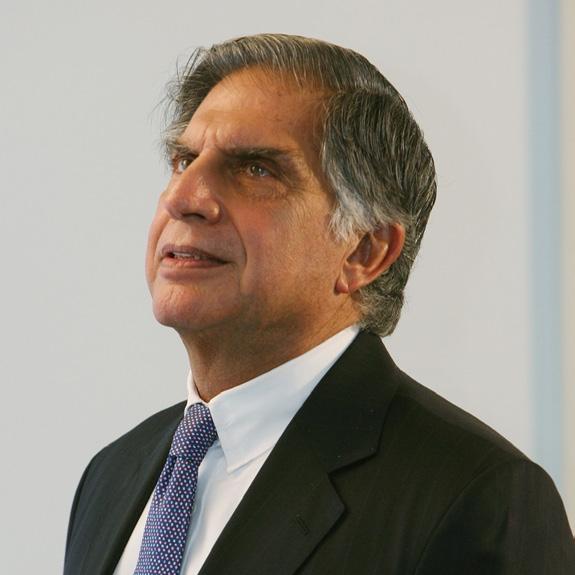
5 minute read
Ratan Tata: The architect of India’s global industrial footprint
From the editor’s desk
Ratan Tata’s legacy in Indian industry is one that extends far beyond his tenure as the Chairman of the Tata Group. His leadership was marked not just by the expansion of the Tata conglomerate but by a visionary approach that pushed boundaries, reshaped industries, and placed Indian enterprise on the global stage. Yet, the true measure of his success is not only in financial metrics or the number of subsidiaries under the Tata umbrella, but in the enduring impact of his decisions on India's economy, its people, and the ethical standards of business leadership.
One of the most significant industries that Ratan Tata transformed was the automotive sector. When Tata Motors launched the Tata Indica in 1998, it was India’s first homegrown car—a product of Indian ingenuity and engineering at a time when the country was dominated by foreign brands. While the car initially met with skepticism, it went on to revolutionize the Indian auto industry. The Indica's success was a turning point, proving that India could compete in the global automotive market, not as a mere assembler of foreign parts but as a creator of its own vehicles.
Perhaps even more emblematic of his ambition was the introduction of the Tata Nano. The Nano was a project with a lofty vision: to offer an affordable, reliable car for the Indian middle class. Priced at around one lakh rupees, it was billed as the world’s cheapest car, designed to wean millions off two-wheelers and onto four. While the Nano’s commercial success was limited, its cultural and industrial significance was profound. It was a symbol of Tata’s larger strategy—to democratize access to products that were traditionally seen as luxuries, reinforcing his commitment to innovation with a purpose.

Tata's automotive ventures, however, were not confined to India. His leadership propelled the Tata Group into the global arena, with acquisitions that shocked and awed industry watchers. The purchase of Jaguar Land Rover (JLR) in 2008 was a particularly bold move. At the time, many questioned the wisdom of an Indian company acquiring two of the most iconic British automotive brands, especially in the wake of the global financial crisis. However, Tata’s ability to integrate JLR into the fold, while respecting the brands’ legacy, proved to be a masterstroke. Under Tata’s stewardship, JLR returned to profitability, and the acquisition became a landmark case of successful global expansion by an Indian company. Similarly, the acquisition of Corus Steel in 2007 signaled India’s arrival as a global player in heavy industry.
Ratan Tata’s vision extended well beyond growth through acquisition. His emphasis on innovation, particularly in sustainability, was forwardthinking, placing the Tata Group at the forefront of technological advancements in various sectors. Under his leadership, Tata Motors made significant strides in the development of electric vehicles (EVs), positioning itself as a leader in India’s nascent but rapidly growing EV market. Tata understood early that the future of transportation lay in sustainability, and his investments in this domain were a testament to his foresight. However, Ratan Tata’s influence was not restricted to the boardroom. His philanthropic efforts were vast, though often understated. Through the Tata Trusts, he directed a significant portion of the group’s profits toward social causes. Unlike many business magnates who see charity as a secondary responsibility, Tata viewed it as integral to his corporate strategy. His contributions to education, healthcare, and rural development have improved the lives of millions across India. This holistic approach to business, where profitability was balanced with social responsibility, set him apart from his peers.
One of the most enduring aspects of Ratan Tata’s legacy is his unwavering commitment to ethical leadership. In an era where corporate governance scandals have become all too common, Tata remained a bastion of integrity. His decisions, even the difficult ones, were made with a deep sense of accountability to shareholders, employees, and the broader society. This adherence to ethics was not merely a personal trait but became a defining characteristic of the Tata Group under his leadership. He showed that it was possible to be both profitable and principled, a message that resonates in a world increasingly concerned with corporate malfeasance.
The potential long-term impacts of Tata’s leadership are immense. His early bets on sustainability, especially in the EV sector, could very well pay off in a future where the demand for environmentally friendly technologies is only increasing. Tata Motors, with its electric vehicle lineup, is wellpositioned to capitalize on this shift, potentially becoming a dominant player not just in India, but globally.
Similarly, the acquisitions made under his leadership, particularly Jaguar Land Rover and Corus Steel, have laid the groundwork for continued global expansion. These companies are no longer seen as foreign entities under Indian ownership but are respected as integral parts of the Tata ecosystem. This shift in perception is vital for future endeavors, as it demonstrates that Indian companies can not only compete globally but can also preserve and enhance the value of established international brands. In a broader sense, Ratan Tata’s legacy has redefined what it means to be a global industrialist in the 21st century. His belief in the importance of ethical leadership, his commitment to social impact, and his understanding of the need for innovation in a rapidly changing world are lessons that future generations of business leaders would do well to learn. India’s industrial landscape is richer, more dynamic, and more globally integrated because of Ratan Tata, and the true scope of his contributions will likely be felt for decades to come.
Ratan Tata’s legacy extends far beyond the growth of an empire; it has shaped a future for Indian industry that stands rooted in both ethical integrity and enduring prosperity.










